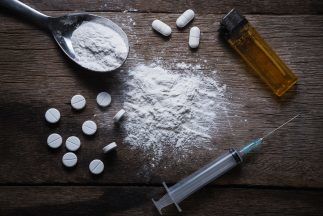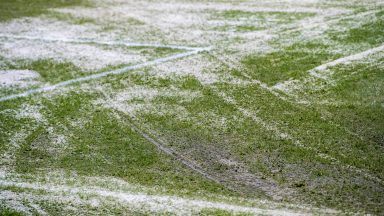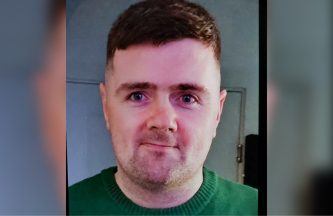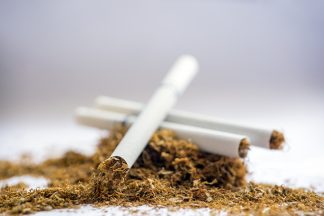New synthetic opioids much stronger than heroin have been banned across the UK in a bid to prevent drug deaths.
The UK Government said on Wednesday a total of 15 synthetic opioids – including 14 nitazenes – are now controlled as Class A drugs under the Misuse of Drugs Act 1971.
Nitazenes are highly potent drugs that can be many times stronger than more common opioids.
In the UK, they have been detected in substances sold as other opioids, benzodiazepines, and cannabis products.
Many consumers are using nitazenes inadvertently, unaware of the risks they face, according the general medical journal The Lancet.
Like other opioids, nitazenes can cause fatal respiratory depression, and some are hundreds of times more potent than heroin.
The UK Government said on Wednesday it has now acted to ban nitazenes after recommendations made by the Advisory Council on the Misuse of Drugs (ACMD).
Three stimulants, a synthetic cannabinoid receptor agonist (SCRA) and a benzodiazepine have also been banned.
Home secretary James Cleverly said: “We are highly alert to the threat from synthetic drugs and have been taking a range of preventative action, learning from experiences around the globe, to keep these vile drugs off our streets.
“Our plan is working – the overall quantities of synthetic opioids reaching the UK remain lower than other countries, but we are not complacent. Placing these toxic drugs under the strictest controls sends a clear message that the consequences for peddling them will be severe.”
The UK Government says it is sending a clear message to anyone involved in the production or supply of the drugs that they will face the full force of the law – including up to life in prison, an unlimited fine, or both.
Those caught in possession of such drugs could face up to seven years imprisonment, an unlimited fine or both.
The announcement comes after latest figures published last week from Police Scotland showed that the number of suspected drug deaths in Scotland rose by 10% last year.
There were 1,197 suspected drug deaths between January and December 2023, 105 more than during the same period in 2022 (1,092).
Meanwhile, Public Health Scotland, in partnership with Bristol and Glasgow Caledonian universities, published figures on Tuesday that showed more than 47,000 Scots were estimated to be addicted to opioids.
John Lamont, the UK Government minister for Scotland, said: “Super-strong synthetic opioids have been posing a growing threat in Scotland and we hope their elevation today to Class-A banned substances will act as a further deterrent.
“Illegal drugs destroy lives and devastate communities. We are committed to preventing drug use by supporting people through treatment and recovery and tackling the supply of illegal drugs, as set out in our ten-year drug strategy backed by a record £3bn funding.”
The 15 new synthetic opioids which have been made Class A drugs under the Misuse of Drugs Act 1971:
o Metonitazene,
o Protonitazene,
o Isotonitazene,
o Butonitazene,
o Flunitazene,
o Metodesnitazene (metazene),
o Etodesnitazene (etazene),
o N-Pyrrolidino-etonitazene (Etonitazepyne),
o N-Piperidinyl-etonitazene (Etonitazepipne),
o N-Pyrrolidino Protonitazene,
o Ethyleneoxynitazene,
o N-Desethyl protonitazene,
o N-Desethylisotonitazene,
o N-Desethyl-etonitazene, and
o Brorphine.
Five other drugs have also been banned, including three stimulants- diphenidine, ephenidine and methoxyphenidine- which create similar effects to ketamine. These can cause complications such as seizures and liver failure and are now controlled as Class B drugs.
A synthetic cannabinoid receptor agonist (SCRA) called cumyl-PeGaClone has also been controlled as a Class B drug and a short-acting benzodiazepine drug named remimazolam is now Class C.
More than 100 deaths linked to synthetic opioids
More than 100 deaths have now been linked to synthetic opioids called nitazenes since the summer, according to the National Crime Agency (NCA).
Dr Mark Pucci, who observed 19 patients who tested positive for the new drugs in the West Midlands between July and October 2023, says flawed data collection methods mean the numbers are a significant underestimate.
The drugs are stronger than heroin and fentanyl, a prolific killer in the US.
The government says it is highly alert to the threat but admits there are “information gaps” about the drugs.
The NCA believes nitazenes are produced in illicit labs in China and are entering the UK through the Royal Mail and other parcel operators.
In most cases, they are then cut and mixed with heroin by organised gangs, strengthening the drugs being sold on the street.
They have also been found in samples of illegal diazepam tablets, most likely bought online.
Alongside law enforcement agencies, the UK Department for Health and Social Care has joined a cross-government taskforce to lead the response.
Critics, however, say the authorities have not acted fast enough to track non-fatal overdoses involving nitazenes.
Tracking overdose data can show where the drugs have spread and predict and prevent deaths.
What are nitazenes?
- Nitazenes were first developed in the 1950s as a pain-killing medication but are so potent and addictive they have never been approved for medical or therapeutic use
- Injected, inhaled or swallowed, mixing them with other drugs and alcohol is extremely dangerous and significantly increases the risk of overdose and death
- The new drugs are covered by the Psychoactive Substances Act 2016, but the government said last year it wanted to classify 15 synthetic opioids as Class A drugs
Follow STV News on WhatsApp
Scan the QR code on your mobile device for all the latest news from around the country





























